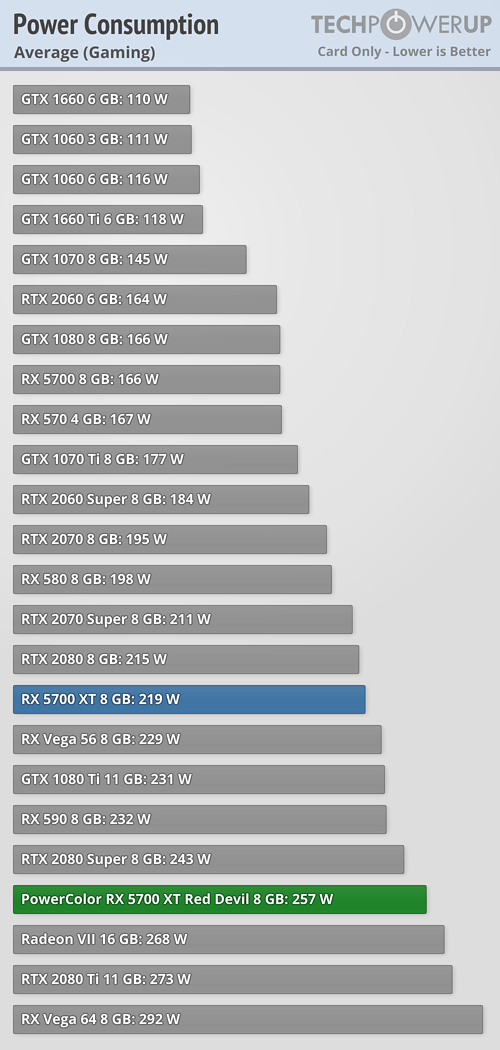 40
40
PowerColor Radeon RX 5700 XT Red Devil Review
Temperatures & Fan Noise »Power Consumption
Non-gaming power consumption is increased a bit over the AMD reference design. With 7 W more, it's not as dramatic as it looks in the charts. Like on all other Navi cards, multi-monitor power consumption is still too high when compared to that of competing NVIDIA cards.
Gaming power consumption is around 40 W higher than the AMD reference design, which is partially expected because of increased clock speeds out of the box. Compared to other RX 5700 XT cards we've tested, the increase in power draw is a little bit higher.
Minimum recommended PSU: 550 W






Feb 11th, 2025 15:19 EST
change timezone
Latest GPU Drivers
New Forum Posts
- How does MS Store remember my previous apps? (12)
- It's happening again, melting 12v high pwr connectors (215)
- Copying big amount data from HDD (13)
- What are you playing? (22855)
- Last game you purchased? (681)
- How bad is Denuvo? (9)
- Were Ryzen 8000 CPUs a big mistake from AMD? (3)
- Do I need to spend extra money on my MOBO? (14)
- Proposed new Power Connector (15)
- Have you got pie today? (16585)
Popular Reviews
- Civilization VII Performance Benchmark Review - 35 GPUs Tested
- Kingdom Come Deliverance II Performance Benchmark Review - 35 GPUs Tested
- ASRock Phantom Gaming B850I Lightning Wi-Fi Review
- Team Group T-Force XTREEM DDR5-7200 48GB CL34 Review
- Spider-Man 2 Performance Benchmark Review - 35 GPUs Tested
- NVIDIA GeForce RTX 5080 Founders Edition Review
- AMD Ryzen 7 9800X3D Review - The Best Gaming Processor
- DAREU A980 Pro Max Review
- Kingdom Come: Deliverance 2 Handheld Performance Review
- Corsair Frame 4000D Review
Controversial News Posts
- AMD Radeon 9070 XT Rumored to Outpace RTX 5070 Ti by Almost 15% (287)
- AMD is Taking Time with Radeon RX 9000 to Optimize Software and FSR 4 (256)
- AMD Denies Radeon RX 9070 XT $899 USD Starting Price Point Rumors (239)
- Edward Snowden Lashes Out at NVIDIA Over GeForce RTX 50 Pricing And Value (239)
- AMD Radeon RX 9070 XT & RX 9070 Custom Models In Stock at European Stores (226)
- New Leak Reveals NVIDIA RTX 5080 Is Slower Than RTX 4090 (215)
- AMD's Radeon RX 9070 Launch Faces Pricing Hurdles (175)
- AMD Radeon RX 9070 XT Tested in Cyberpunk 2077 and Black Myth: Wukong (169)